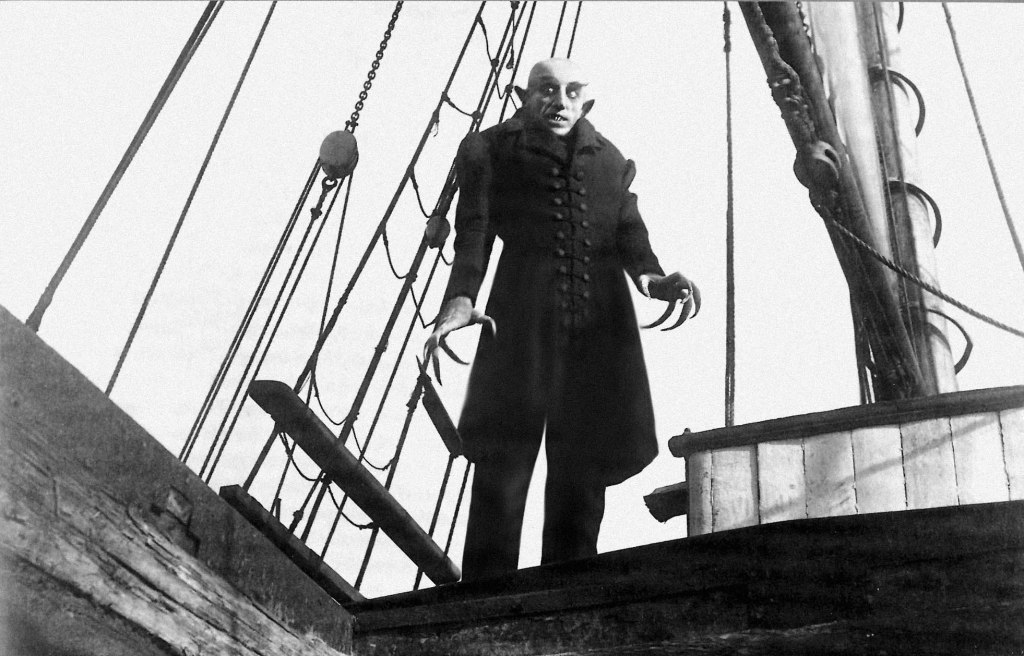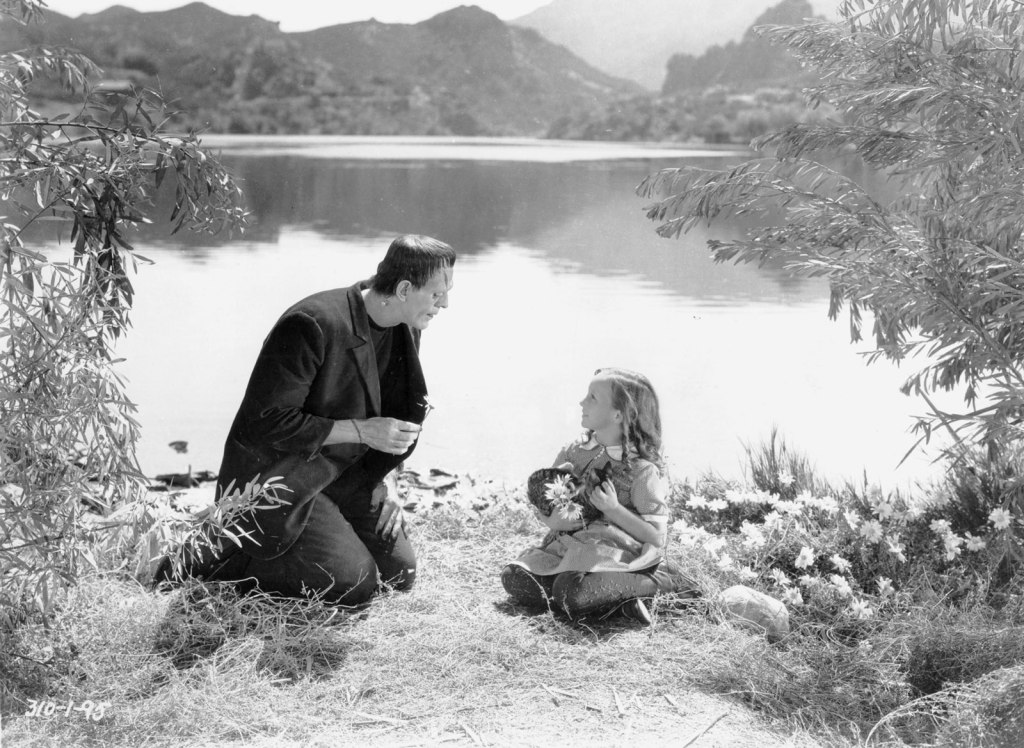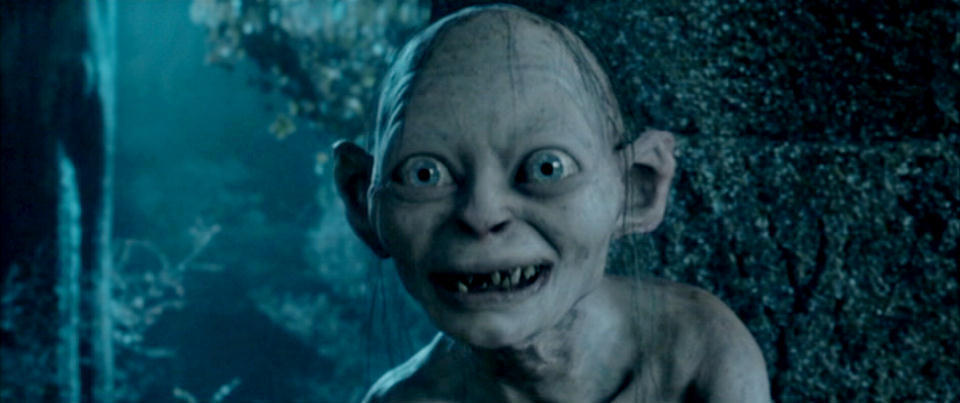I’ve been spending a portion of my wee small hours (normally spent standing under a solitary street lamp on a lonely street, staring in melancholy reverie at my cigarette) revisiting old horror films. As a budding cult film obsessive, I cut my teeth on the horror films of cinema’s early decades. In the days before home video and cable, networks packed their late-night hours with old horror movies, much to the delight of insomniac little night owls such as me. Stoking these fires further was the proliferation of monster magazines and books. I had a book series with a volume for each famous monster, and in it were two pictures that terrified and fascinated me: one of Count Orlok from F.W. Murnau’s classic Nosferatu and the other a full-color still of Christopher Lee’s gruesome monster from Hammer’s Curse of Frankenstein. I would alternately look at them then fearfully sequester the books away in my closet, only to skulk over and sneak another peak at those grotesque yet captivating horrors.
One of my first horror movies was Universal’s Frankenstein. Frankenstein (let’s not do the “that was the name of the doctor, not the monster thing,” OK?) remains my favorite monster. I loved the sets, the creepy castles, the mad scientist labs, the scenes of a monster lumbering across mist-shrouded graveyards full of crooked crosses looking more like the No Man’s Land than an actual cemetery. But above all, I adored the monster, this horrifying thing that looked like us but was not one of us, that did not ask to be made but was never the less there, hated and hounded for simply being different and not understanding. Frankenstein’s look is iconic partly because of the make-up, but more so thanks to the performance of Boris Karloff and a script that gives us a monster we root for not because we hate the humans (as would become the case in slasher films) but because we sympathize with the monster.

Early horror is full of this type of monster. Some were more sympathetic than others, but all of them were memorable. Lon Chaney as the Phantom or as the legless fiend in The Penalty or…well, pretty much any horror film he did. His son’s turn as the hapless sad sack in The Wolfman. The Gillman of The Creature from the Black Lagoon, who was just keeping to himself and backstroking the hell out of that lagoon until humans started poking around and declared him a monster to be captured or killed. Conrad Veidt as the heartbreaking Gwynplaine in The Man Who Laughs. I watched that movie wracked with tension because he was such a sympathetic monster and I knew there was a very good chance that things would end horribly for him and those around him.

We understood these monsters. What weird little kid didn’t understand and relate to Frankenstein? Who couldn’t see the pathos in poor, good-natured Larry Talbot turning into a beast? Or Frankenstein misunderstanding the throwing of pretty things into a well? As children, we lack the vocabulary to express ourselves, and we feel frustrated trying to communicate with adults who are not evil but simply cannot understand us. There is a cathartic reaction to seeing this alienation expressed via one of these monsters. At their best, they could manipulate our emotions and tug on our heartstrings with all the melodramatic aplomb of Shakespeare. I remember hearing stories of people seeing Frankenstein or King Kong for the first time. Upon initial reveal of the monster, audiences would gasp and swoon. But by the end, no one cheers for the defeat of the thing that so horrified them when first they saw it. No one is happy when Frankenstein is destroyed or when King Kong slips off the Empire State Building. We have gone from gasping horror to understanding to pathos, and finally, to sadness at the fate of these monsters — and that does not happen because of great make-up or wonderful special effects.

Compare these very human monsters-as-characters to what monsters have become. We are in an era when movie monsters have become almost uniformly generic and free of any personality beyond “it’s a sort of CGI tentacle dog bug thing that kills people.” Such things can be effective and fun, but it’s a shame they’ve become very nearly the sole representation of monsters on screen and that the idea of a monster as a character has been all but abandoned. What’s the last screen monster people came away from the movie talking about — not talking about the movie, but the monster itself? What’s the last monster some little kid drew on his school folder? What bundle of drooling fangs has stood out from the pack as something memorable that could endure for a century and fascinate new generations decade after decade? The alien from Alien perhaps, or the Predator — but again, I’d argue that both of these monsters are memorable because they are given character beyond “it runs fasts and is covered in slime.”
I miss “the human monster,” the tragic creature who becomes the villain of the piece despite not being evil, the monster so well characterized and realized by an actor that the image of them becomes part of our collective cultural consciousness, their names shorthand for entire concepts and moods. Paranormal romance flirts with humanized monsters. Edward Cullen may not be everyone’s favorite vampire, but he and that muscular werewolf who can’t afford shirts are still monsters (of sorts) with character. If anyone has come close to realizing the human monster, it’s Guillermo del Toro and Ron Pelrman with Hellboy. Hellboy is an actual character, perhaps not as persecuted as some of the monsters of old — he at least gets to hold down a job. He’s a monster that succeeds because someone took the time to write the monster, rather than just generate it, and an actor took the time to give the monster personality. A movie took the time to make me care about the monster, to make it something more than just an interchangeable threat to some group of interchangeable humans.

It’s no surprise that it’s del Toro who did this — he has true affection for classic horror, drawing inspiration without mimicking them. Even the villainous monsters — the elf prince in Golden Army, or the giant tree spirit — are sympathetic and have motivation. Frankenstein’s monster enjoying a cigar and growling, “Goooood!” before it goes tragically wrong is one of my favorite human monster moments. Abe Sapien and Hellboy getting drunk and listening to Barry Manilow very nearly equals that scene.
I’d be remiss if I didn’t mention Andy Serkis’ poor, pathetic Gollum, who proves that CGI is not the problem so much as it is a dearth of imagination on behalf of writers and designers. Even though he’s a CGI creation, Gollum depends on Serkis. No one goes ape over how Gollum looks; the talk is always about how Andy Serkis performs. In this case, the CGI is used not to create the monster so much as it is used in place of traditional make-up to clothe the performer. Peter Jackson’s Lord of the Rings trilogy isn’t horror, but like del Toro, Jackson is a director with tremendous affection for classic horror and human monsters (though he seems in danger of losing himself George Lucas-style to fascination with technology over storytelling).

The tragedy is that characterless beasts are, with extremely rare exception, all we have. CGI beasts, anonymous zombies, and vague supernatural threats who can think of nothing to do to us other than make us fly backwards across rooms really fast or, for some reason, do back bends and other weird, contortive acts. Like peasants armed with pitchforks and torches, we’ve run the concept of monsters as tragic figures, monsters as real characters, out of the village and forced them to take refuge in the forest of Guillermo del Toro’s beard. Perhaps this is symptomatic of genre filmmakers/writer deciding to operate in the realm of archetypes and assumed familiar character stereotypes that do not need to be written. You can’t depend on shorthand to create Frankenstein or Larry Talbot. You can’t really fall back on, “Eh, you get the gist of things” and have a computer generate a monster that will be remembered a hundred years from now, hung on doors during Halloween, recognized even by people who have never seen the movie that gave birth to the creature.
I suppose until things change — I’m optimistic we will come around again to this style of writing monsters — we should be thankful we live in an era where human monsters might not grace our movie theaters, but they are still there for us on DVD. In a way, I guess nothing has changed for me. In 1978 or so, I discovered and became obsessed with these old monsters while huddled in the dark, watching them on television. And here I am over three decades later, doing much the same. It’s a shame that the continued niche nature of television, and the move away from filling the late night hours with old movies and toward just slapping on some infomercials, means kids won’t be able to stumble upon these fabulous creatures the same way we did. But they are there never the less, waiting to make you cry out in terror then do your best to hold back a sniffle once terrible fate has run its course.
When he’s not explaining some obscure historical or anthropological point while oblivious to the fact that he is slowly sinking in quicksand, Keith Allison runs the cult culture website Teleport City.
Categories: Guest Star






A lovely piece, Keith. I had a very similar childhood, though I had to visit the monster series books at the library. I remember sitting on the floor of my elementary school library turning the pages and wanting more pictures of the all the monsters, though I especially loved the Wolf Man and the Creature from the Black Lagoon.
It took me a long time to realize I was a horror fan, despite my love of monsters and classic horror and science fiction. But I have discovered that I prefer my monsters mixed with tragedy, though I can’t always bear to watch their ends. I don’t remember the last time I watched the end of King Kong. I am certain that if I don’t, he never falls.
Anyway, thank you again.
LikeLike
I don’t remember the last time I watched the end of King Kong. I am certain that if I don’t, he never falls.
Kong is one of my favorite movies. I watch it once a year. And even though I do watch the end, I love the idea that there is an alternative universe where Kong survived the airplanes and is still wandering around on the East Coast, looking for Ann Darrow, who is always one step ahead of him.
(It’s kind of like “The Fugitive.”)
LikeLike
So glad to hear I’m not the only person who used to deliberately scare myself with pictures then hide them. When I was very young I used to obsessively read and re-read one particular version of ‘Red Riding Hood’ — just to get the point where the wolf leapt out. I’d read it eight, ten times in a row, then hide it under my parents’ bed.
LikeLike
Now I’m imagining King kong skulking around the east coast wearing a trenchcoat and fedora like Dr. Gori’s sidekick in Spectreman
LikeLike